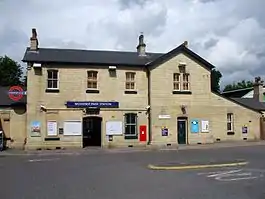Woodside Park tube station
Woodside Park is a London Underground station in Woodside Park, north London.
| Woodside Park | |
|---|---|
 | |
 Woodside Park Location of Woodside Park in Greater London | |
| Location | Woodside Park |
| Local authority | London Borough of Barnet |
| Managed by | London Underground |
| Number of platforms | 2 |
| Fare zone | 4 |
| London Underground annual entry and exit | |
| 2015 | |
| 2016 | |
| 2017 | |
| 2018 | |
| 2019 | |
| Railway companies | |
| Original company | Edgware, Highgate and London Railway |
| Pre-grouping | Great Northern Railway |
| Post-grouping | LNER |
| Key dates | |
| 1 April 1872 | Opened by EH&LR as Torrington Park[4] |
| 1872 | Renamed as Torrington Park, Woodside[4] |
| 1882 | Renamed as Woodside Park[4][5] |
| 14 April 1940 | Northern line services started |
| 1941 | LNER services ended |
| 1 October 1962 | Goods yard closed[6] |
| Other information | |
| External links | |
| WGS84 | 51.61806°N 0.18556°W |

The station is on the High Barnet branch of the Northern line, between West Finchley and Totteridge and Whetstone stations, and in Travelcard Zone 4. Woodside Park is the last station in an alphabetical list of London Underground stations.
History
Woodside Park station was planned by the Edgware, Highgate and London Railway (EH&LR) and was originally opened as Torrington Park on 1 April 1872 by the Great Northern Railway[4] (which had taken over the EH&LR).[7] The station was on a branch of a line that ran from Finsbury Park to Edgware via Highgate. The station was renamed within a month of opening, and again in 1882.[4][5]
After the 1921 Railways Act created the Big Four railway companies the line was, from 1923, part of the London & North Eastern Railway (LNER). The section of the High Barnet branch north of East Finchley was incorporated into the London Underground network through the "Northern Heights" project begun in the late 1930s. The station was first served by Northern line trains on 14 April 1940[8] and, after a period where the station was serviced by both operators, LNER services ended in 1941.[7] The station still retains much of its original Victorian architectural character today.
British Rail (the successor to the LNER) freight trains continued to serve the station's goods yard until 1 October 1962, when it was closed.[6]
Incidents
The Provisional IRA exploded a bomb at the station's car park on 10 December 1992, during the afternoon rush hour. Commuters and residents were evacuated, though no-one was injured. The station is close to the Inglis Barracks, where a British soldier was killed by an IRA bombing in 1988.[9]
Connections
London Buses route 383 serves the station.
Local information
The station has a large adjacent area, originally for storing coal and now used as a car park. Until about 2000, there was a second car park. A block of flats has now been built on this area.
The station is above ground. Both platforms are readily accessible from the street by wheelchair. The main entrance, with ticket office, is at the end of a cul-de-sac (Woodside Park Road), adjacent to the car park entrance. This leads on to the southbound platform. A Victorian post box is set into the front wall of the station.
The entrance leading on to the northbound platform is at the end of the cul-de-sac (Station Road), a turning off Holden Road.
References
Notes
- "Multi-year station entry-and-exit figures (2007–2017)" (XLSX). London Underground station passenger usage data. Transport for London. January 2018. Retrieved 22 July 2018.
- "Station Usage Data" (CSV). Usage Statistics for London Stations, 2018. Transport for London. 21 August 2019. Retrieved 27 April 2020.
- "Station Usage Data" (XLSX). Usage Statistics for London Stations, 2019. Transport for London. 23 September 2020. Retrieved 9 November 2020.
- Butt (1995), page 231
- Butt (1995), page 254
- "News Flash 80" (PDF). Underground: The Journal of the London Underground Railway Society. No. 12. December 1962. p. 7. Retrieved 28 November 2017.
- Clive's Underground Line Guides - Northern Line, Dates
- Rose (1999)
- Kathy Marks (10 December 1992). "Bomb in van explodes at rush hour Tube station". The Independent.
Sources
- Butt, R. V. J. (1995). The Directory of Railway Stations: details every public and private passenger station, halt, platform and stopping place, past and present (1st ed.). Sparkford: Patrick Stephens Ltd. ISBN 978-1-85260-508-7. OCLC 60251199.
- Jowett, Alan (March 1989). Jowett's Railway Atlas of Great Britain and Ireland: From Pre-Grouping to the Present Day (1st ed.). Sparkford: Patrick Stephens Ltd. ISBN 978-1-85260-086-0. OCLC 22311137.
- Rose, Douglas (1999). The London Underground, A Diagrammatic History (7th ed.). Capital Transport Publishing. ISBN 1-8541-4219-4. OCLC 59556887.
External links
| Wikimedia Commons has media related to Woodside Park tube station. |
| Preceding station | Following station | |||
|---|---|---|---|---|
towards High Barnet | Northern line High Barnet Branch |